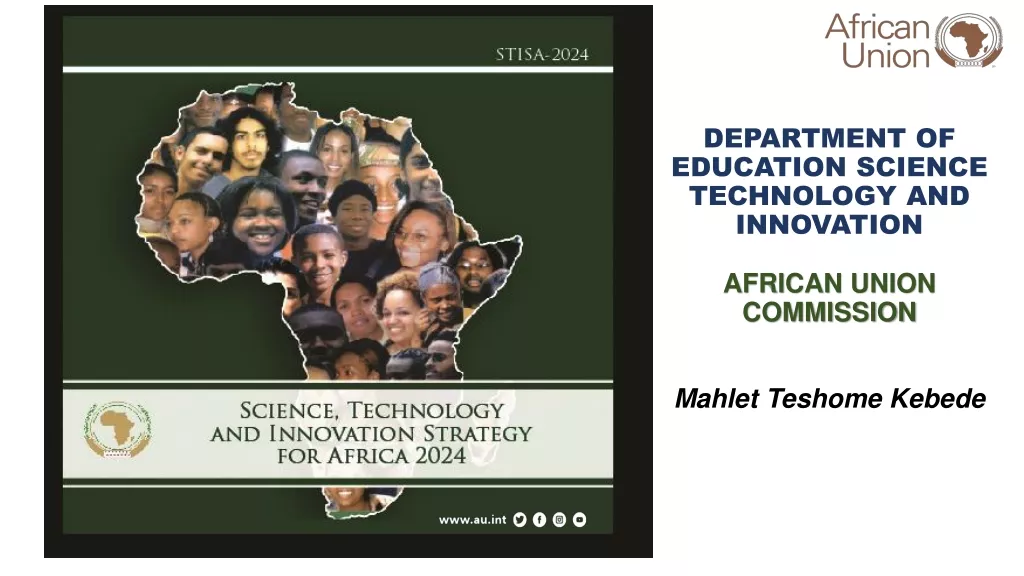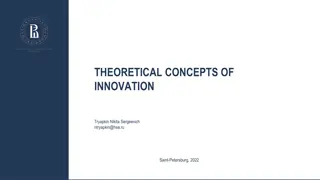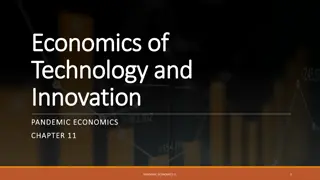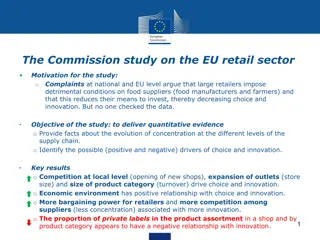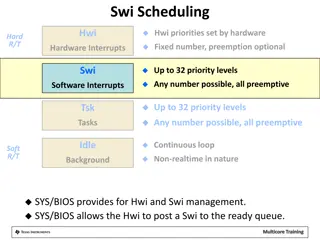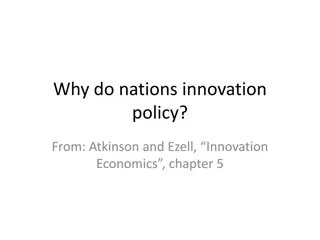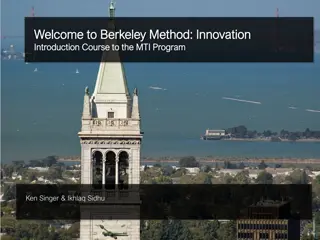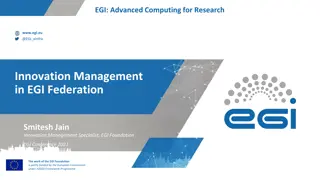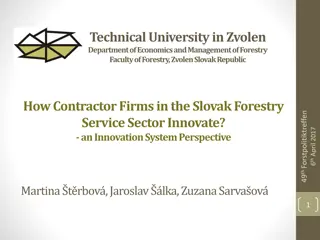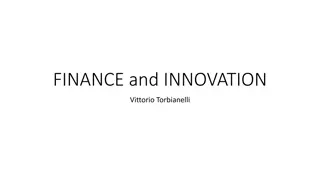
Innovation Systems for Inclusive Agricultural Development in India
Explore the transition from S&T-led agricultural production to innovation systems in India, focusing on the importance of inclusive development through technological and institutional innovation. Delve into the significance of institutions in addressing climate change, financialization, knowledge distribution, gender issues, and more for sustainable growth.
Download Presentation

Please find below an Image/Link to download the presentation.
The content on the website is provided AS IS for your information and personal use only. It may not be sold, licensed, or shared on other websites without obtaining consent from the author. If you encounter any issues during the download, it is possible that the publisher has removed the file from their server.
You are allowed to download the files provided on this website for personal or commercial use, subject to the condition that they are used lawfully. All files are the property of their respective owners.
The content on the website is provided AS IS for your information and personal use only. It may not be sold, licensed, or shared on other websites without obtaining consent from the author.
E N D
Presentation Transcript
From S&T led Agricultural Production to Agricultural Innovation Systems INDIALICS Training Programme CDS, Trivandum 19-03-2016 R. S. Raina, CSIR-NISTADS
Agriculture in India- an overview Profile 2009-10 2010-11 2011-12 2012-13 2013-14 GDP at factor cost (2004-05 prices) (Rs. Crores) Growth Rate (%) Agriculture Share in total GDP (%) Growth rate (%) Agriculture Agricultural GDP (%) Food grains (Million tonnes) Agriculture Share in total GCF (%) Share of Agriculture in Agricultural GCF (%) Agricultural GCF as a % of Agricultural GDP (%) Share of private sector (%) Agricultural including marine products as percent of total exports (%) 19-03-2016 4516071 4918533 8.9 5247530 6.7 5482111 4.5 5741791 4.7 8.6 14.6 0.8 14.6 8.6 14.4 5 13.9 1.4 13.5 4.7 Share in 12.3 218.1 12.4 244.5 12.3 259.3 11.8 257.1 n.a. 264.4 7.3 6.7 6.3 5.8 7.0 6.5 7.1 6.5 n.a. n.a. 20.1 16.7 18.5 15.7 20.8 18.0 212 18.1 n.a. n.a. exports 8.2 8.0 10.1 11.8 11.9 R. S. Raina, CSIR-NISTADS
Why innovation for inclusive development? When we have - Re-distribution with increased expenditure or flagship programmes for the poor Public sector mandates to target rural areas and backward regions, population groups, etc. New private and public-private partnerships and investments in services, extractive and manufacturing industry, agriculture Attempts to enable and promote pro-poor knowledge and technology generation ..Others Why Innovation ? Because Inclusion is Historically Conditioned, Socially Embedded and Politically.-Economically Linked 19-03-2016 R. S. Raina, CSIR-NISTADS
Can Innovation Systems deliver inclusive development? Three major pitfalls in Innovation Systems research .. 1. Technological - AND - Institutional Innovation 2. Sources of Innovation S&T led vs. multiple socially embedded 3. Pathways and Models - linear reasonably uniform vs non-linear evolutionary (CCC) Inability to handle emerging problems 19-03-2016 R. S. Raina, CSIR-NISTADS
Institutions Matter -climate change, financialisation problems, ownership and distribution of knowledge, gender, violence, prosperity without growth Any institution- stabilized forms of behaviour or habits of thought are axiomatically outdated (Veblen) Institutional economics or the study of the changing patterns of cultural relations which deal with the creation and disposal of scarce material goods and services by individuals and groups in the light of their private and public aims (Kapp, 1968, p.2)- is crucial to understand how innovation takes place and is governed. Institutions, the deep determinants of development , the variables and processes that shape the proximate determinants of growth: factor accumulation, technology adoption and policy choices, (Adam and Dercon, 2009, p. 174; Rodrik et al, 2004; Nelson, 2008; Commission on Growth and Development, 2008), need deeper analysis and explanation of causal relationships. In economics we need to bring back Veblen, Ayers, Commons, Kaldor, Myrdal, Kapp, Hettne, Schumpeter and many others. To work out how innovation systems can be made inclusive to work with Freeman, Nelson, Lundvall, Edquist, .. 19-03-2016 R. S. Raina, CSIR-NISTADS
Illustration- Institutions, capital and their mutual relationships in a NIS (Raina, 2015- Adapted from Table 1.2. in Lundvall et al, 2009, p.18). Institutions or norms govern diverse capital Easier to produce, Reproduce or use Not easy to produce or reproduce Tangible resources Production capital Natural capital Intangible resources Knowledge capital Social capital 19-03-2016 R. S. Raina, CSIR-NISTADS
Institutions: Peaceful co-existence? Or irrefutable analytical basis? NSI- Freeman (1987) + contributions from Nelson (1993) and Lundvall (1992) Two different (yet overlapping) innovation systems discourses (i) Nelson (1993) -legacy of development economics - organized scientific knowledge is a major driver of innovation; focus on S&T based, national empirical evidence of innovation. In the second (Lundvall, 1992), the thematic discourse is about interactions and (ii) Lundvall (1992)- drawing upon the social construction of technology or actor-network theories - learning, cumulative knowledge, structural and functional capabilities; Seeks inter-disciplinary explanations of innovation with credence to institutions or the rules and norms that govern the actors. The narrow (S&T based) and broad (interaction and learning based) approaches to NSI have however, not confronted each other. They enjoy a peaceful co-existence (Edquist and Hommen, 2008) Few attempts to bridge or reconcile their differences. A reconciliation between these two approaches is important, given the overarching institutions or norms of development that govern both S&T actors and the development sectors (agriculture and industry)critical to rural poverty. 19-03-2016 R. S. Raina, CSIR-NISTADS
Institutions matter in agriculture Norms of public policy development legitimizations, contents and designs of schemes, Institutions of production tenancy, access to resources, knowledge services, production inputs/services, Norms of valuation of resources (land and water, and energy- labour, mechanical), outputs, gender relationships, caste, Regulations linked markets, standards, quality, safety, 19-03-2016 R. S. Raina, CSIR-NISTADS
S&T led Agricultural Production Agricultural production programmes Irrigation, DoAC, DoAH, IFPRI, State Departments, S&T application in programmes ICAR CRIDA/ CAZRI, SAUs, ICRISAT, ICARDA, Intermediary agencies NABARD, Irrigation departments, APMC, PACS, .. Industry for input supply Chemicals - FAI, Syngenta, Mahyco- Monsanto, Famers associations BKU, ..(demanding MSP, subsidies, concerns about labour, mechanization,) 19-03-2016 R. S. Raina, CSIR-NISTADS
But knowledge (S&T) and policy are part a larger institutional framework - the Supply Syndrome During 1990-2009 agricultural R&D received less than 0.4 % of the Agrl GDP Input subsidies alone 8-11 % of agricultural GDP Input subsidies account for 88 % of the total plan outlay of agriculture, irrigation and rural development (Vaidyanathan, 2010) Fertilizer subsidy 2012-13 - Rs. 90,000 crores Significant decline or stagnation in incremental response to input use (irrigation and chemical fertilizers Vaidyanathan, 2010), and growth rates of rice-wheat production (ibid, Bhalla and Singh, 2010) 19-03-2016 R. S. Raina, CSIR-NISTADS
Norms of Supply Convergence of Policy, Practice, Knowledge Over the past four decades . From multiple crop/crop-livestock/livestock research to cereal based monoculture research From provincial research stations to centralized Council From higher education for rural development to specialised agricultural universities From community development programmes to sub-sector specific extension services, technologies, inputs & subsidies From local markets to levied (MSP) stocks for FCI PDS- global trade From local inputs /services to industrial inputs- chemical, mechanical, financial, biological inputs from industry From rainfall and locally managed irrigation to large dams 19-03-2016 R. S. Raina, CSIR-NISTADS
Disenchantment with an incorrigible S&T . It is necessary to take a comprehensive view of the functioning of the agricultural research system and make systemic changes in the course of the Eleventh Plan. Thus far, research has tended to focus mostly on increasing the yield potential by more intensive use of water and biochemical inputs. Far too little attention has been given to the long-term environmental impact or on methods and practices for the efficient use of these inputs for sustainable agriculture. These features are widely known but efforts to correct them have not been adequate; at any rate they have not made much of a difference (Government of India, 2008, Vol. 3, pg. 13). 19-03-2016 R. S. Raina, CSIR-NISTADS
More than half of arable land is rainfed 61% of net sown area is rainfed 84% of rural poor reside in rainfed areas The BIG 5 farmers suicides 34 predominant crops Over 80 % of the pulses, horticultural, livestock products . 19-03-2016 R. S. Raina, CSIR-NISTADS
The Story of Rainfed Areas!! What is the relevant framework for development of rainfed areas? 19-03-2016 22-08-2013 R. S. Raina, CSIR-NISTADS ResRA- RRA Network
Lopsided Public investments (1997-98 to 2011-12) rainfed agriculture vs. irrigated agriculture (Source: estimated by CBGA, RRA Network) 19-03-2016 R. S. Raina, CSIR-NISTADS
The Paradigm Shift Strategies/ programs conceptualized at the top- technologies generated - prescribed Extension systems Schemes designed for implementation Conventional/Main stream Local problems- local solutions - iterative - technological learning S&T capacities developed in the Blocks Location specific strategies identified and programs evolved Modern Systemic/ RRA 19-03-2016 22-08-2013 R. S. Raina, CSIR-NISTADS ResRA- RRA Network
The RRA network is attempting to evolve a framework and advocates for Differentiated Policies for rainfed agriculture (including livestock and fisheries) Substantial scaling up of public investments for revitalising rainfed areas Appropriate Framework for public investments Appropriate Institutional Systems 19-03-2016 R. S. Raina, CSIR-NISTADS
The dominant discourse neglect of rainfed areas Policy problem low yield or productivity Assumptions that investments in irrigated agriculture is extendable to rainfed areas - that technology and inputs can be supplied from S&T to line departments to farmers - that the diversity and variability of rainfed farming systems can be handled by the supply-driven system Policy actors S&T led and politically legitimized schemes- food security RRA articulation of high potential for sustainable, equitable development (the example of Bt MECH hybrids) 19-03-2016 R. S. Raina, CSIR-NISTADS
in a context of minimal Policy engagements in agriculture, not to speak of rainfed . In India Policy documents For Agriculture (2000), Farmers (2007) For Industry Bombay Plan (1948), IDR Act (1951), Industrial policy resolution (1956) (1964,1969, 1970), Industrial Policy Statement (1973, 1977, 1980, 1991, 2004, 2006), National Manufacturing Policy expected soon For Science (1958), Technology (1983), Science & Technology (2003) 19-03-2016 R. S. Raina, CSIR-NISTADS
Recall the convergence Centralisation of Agricultural S&T Year Total Central Government State Governments and UTs 86.77 187.53 239.63 327.05 512.55 765.95 Total NARE 1960-61 1970-71 1980-81 1990-91 2000-01 2009-10 56.27 261.98 470.65 784.67 1443.95 2302.40 143.04 449.51 710.28 1111.72 1956.50 3068.35 19-03-2016 R. S. Raina, CSIR-NISTADS
....was not always the case... Year Ratio Central :State Govts 39:61 26:74 59:41 67:33 71:29 71:29 75:25 75:25 1960-61 1965-66 1974-75 1979-80 1990-91 1997-98 2006-07 2009-10 19-03-2016 R. S. Raina, CSIR-NISTADS
Phases of Agricultural S&T in India Important Phases Year CAGR Centre Pre- consolidation Pre- department (DARE) status Centralized Consolidated Expansion phase Centralized Consolidated phase States Pre- Model Act & SAUs Pre- NAAC & SAUs+ AICRP Phase Centralization phase 1960-61 to 1965-66 -1.96 1966-67 to 1974-75 9.53 1975-76 to 1996-97 7.49 1997-98 to 2009-10 8.15 1960-61 to 1969-70 7.69 1970-71 to 1989-90 1990-91 to 2009-10 2.41 4.58 19-03-2016 R. S. Raina, CSIR-NISTADS
The S&T led Agricultural Production System contradicts the Constitution.. Agriculture, including Agricultural Extension and Research, Protection against Pests and Prevention of Plant Diseases is a State subject (see Entry 14 of List II- State List in the VII Schedule of the Constitution of India). + Distorts the Science-Policy relationship..... + Distorts all effective linkages and interactions between the Natural, Social and Physical capital 19-03-2016 R. S. Raina, CSIR-NISTADS
An agricultural innovation system with pro-active linkages designed for each Block (Raina, 2015- Adapted from Table 1.2. in Lundvall et al, 2009, p.18). Institutions or norms govern diverse capital Easier to produce, Reproduce or use Not easy to produce or reproduce Tangible resources Production capital Natural capital Intangible resources Knowledge capital Social capital 19-03-2016 R. S. Raina, CSIR-NISTADS




